| dc.description.abstract | Long-finned pilot whales (Globicephala melas) are widely distributed and abundant throughout the North Atlantic and sightings have appeared to increase in coastal areas in northern Norway over the past decade. However, little is known about the dynamics and ecological drivers of their movements in this region. Therefore, we deployed 11 satellite-linked tags to determine areas of important habitat, investigate dive behavior in terms of depth use, duration and diel patterns, and look for patterns of group fidelity. The tags were deployed during March-August 2023-2024 in Andøya in northern Norway and provided location and dive information. They transmitted data for 8-116 days (mean = 44) and utilized latitudes from 63 to 71°N along the Norwegian coastline. The whales remained almost exclusively on the continental shelf, mostly in areas close to the coast, only occasionally venturing over the shelf break, but rarely into deep oceanic waters (> 2,000 m). Dive profiles from two individuals show that most of the time (75%) was spent at depths close to the surface (<20 m). Most of the dives were between the 200-500 m in depth and averaged 4-10 minutes in duration. When multiple individuals were tagged within an assumed family group, they appeared to travel together almost all the time. When individuals were tagged within super-groups (=large groups consisting of several assumed family groups), but assumed to belong to different family groups, they coordinated movement from a distance, migrating at the same time and able to leave the group and merge back later on. This study provides novel, important information on the behavior and area use of long-finned pilot whales at the current northern limit of their range in the North Atlantic. This work is important as a baseline for how the species might be affected by anthropogenic activities and climate change. Our work also highlights the need for more coordinated efforts to monitor the movements of vulnerable marine predators, particularly in the northeast Atlantic, where their population structure is poorly understood. | |


 English
English norsk
norsk
